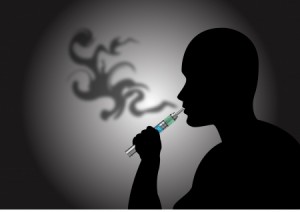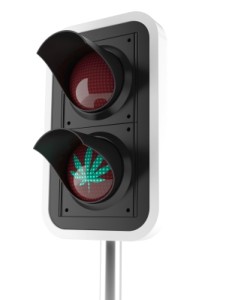E-Cigarettes and E-Joints
E-cigarettes were marketed as safer alternatives to regular cigarettes and even smoking cessation aides. Now they are being modified and marketed as THC delivery systems—an e-joint, if you will. Sound strange? I found several YouTube videos on using or converting e-cigarettes for use with marijuana products like hash oil. Here is a short “how to” video. If you prefer more professional vaporizers, you can try the Wacky Puffer and other commercial products.
It didn’t take too long to get from the first e-cigarette to the e-joint. In was only in 2003 that a Chinese pharmacist developed the first e-cigarette. They were introduced to Europe in 2006 and to the U.S. soon after. In 2008, the WHO said it did not consider the e-cigarette to be a legitimate smoking cessation aid. The first Vapefest was held in March of 2010 in Richmond Virginia. In April of 2011, the FDA announced that e-cigarettes would be regulated like traditional tobacco products under the Food Drug and Cosmetic Act. Any e-cigarette product claiming to help stop smoking or that it provides any other health benefit will be strictly regulated as a drug or medical device.
A July 2014 report by the World Health Organization (WHO) suggested a variety of restrictions for e-cigarettes, including a ban on indoor use of e-cigarettes until “exhaled vapor is proven to be not harmful to bystanders and reasonable evidence exists that smoke-free policy enforcement is not undermined.” The Fix pointed out how the tobacco industry is entering the e-cigarette industry. Phillip Morris International has purchased the UK company Nicocigs, an e-cigarette maker. The Fix has several articles on e-cigarettes available, including pro and con sounding titles.
In October of 2014, six U.S. senators signed a letter to the FDA urging companies to label e-cigarettes, “listing all of the health threats the products pose.” Then there is Dr. Nathan Cobb, an assistant professor of medicine at Georgetown School of Medicine who thinks e-cigarettes could bring down traditional smoking and save thousands of lives in the process. However, Dr. Stanton Glantz, doesn’t believe that e-cigarettes are as effective in helping people quit smoking as marketing claims they are.
This commentary assumes that e-cigarettes, as currently in the marketplace, will help people quit smoking and ignores the consistent evidence from population-based studies that smokers who use e-cigarettes are about one-third less likely to quit smoking.
There is growing concern that e-cigarettes aren’t really that safe. Ryan Aliapoulios on the AfterPartyChat website noted the obvious problem, “they still deliver the same addictive chemical at the root of so many other health problems: nicotine.” He mentioned a study, “A Molecular Basis for Nicotine as a Gateway Drug,” that said while e-cigarettes eliminate some of the morbidity from combustible tobacco, they are “pure nicotine-delivery devices.” They have the same effects on the brain as smoking tobacco and they pose the same risk of addiction.
The authors said the use of e-cigarettes is rapidly increasing among adolescents and young adults. “Our society needs to be concerned about the effect of e-cigarettes on the brain, especially in young people, and the potential for creating a new generation of persons addicted to nicotine.”
In “E-Cigarettes Are Not As Harmless As We’ve Been Told,” The Fix reported that Dr. Glantz and his research team found that e-cigarettes produced greater risk than initially thought, “delivering high levels of nano particles which can trigger inflammation and have been linked to asthma, stroke, heart disease, and diabetes.” Glantz was furthered quoted as saying that e-cigarettes are rapidly increasing in popularity with kids. While they are promoted by tobaccos companies that have purchased e-cigarette companies as a way to quit smoking, a safer less polluting alternative to regular cigarettes, “What the evidence to date shows is that while a puff on an e-cigarette isn’t as dangerous as a puff on a regular cigarette, the main effect they seem to be having is to keep people smoking cigarettes.”
So what about e-joints? They actually exist, according to Scientific American. There is a Dutch company, E-Njoint, BV that has released what it says is the first electronic joint—the E-njoint Disposable. It is battery-powered and vaporizes a liquid vegetable-glycerin and polypropylene-glycol with added flavoring. Polypropylene-glycol is the “e-liquid” used in e-cigarettes. Glycerin is colorless and odorless liquid that is widely used in pharmaceutical formulations.
The next version of the E-Njoint will be both rechargeable and capable of being filled with cannabis or a derivative. “Once the cartridges are empty, users are able to fill these cartridges with a liquid. Those liquids may be standard liquids bought at any store around the world or it could be an extract of a cannabis plant.” The company also plans to release an e-joint that can be used with “dry herbs,” like marijuana.
Pamela Ling of the Tobacco Control Policy Fellowship at the University of California, San Francisco’s Center for Tobacco Research and Education said that while the Dutch company is the first to call its product an ‘electronic joint,’ “the idea of using electronic vaporizers for THC or marijuana is not new, and this company is far from the first. ”
An NPR report on “vape pens,” handheld vaporizers for marijuana, noted how they are reshaping the marijuana business and culture. Two years ago, one man was selling vape pens out of the trunk of his car. Now his company, Grenco Science, has a 6,000 square foot headquarters in central Los Angeles.
The concentrates used in vape pens can be very strong. As I noted in a previous, article, “A Little Dab Will Do Ya,” hash oil concentrations can reach 90 percent THC, while the most potent marijuana is usually no more than 20 percent. These high THC levels are even a concern for Allen St. Pierre, the executive director of NORML, the National Organization to Reform Marijuana Laws:
Between the fact that you can potentially pass out with a single inhalation, or you can have such property damage and potential bodily harm just producing it … these [issues of the vape pen] definitely need to be addressed. . . . This is a screaming call for regulation if there ever was one.




